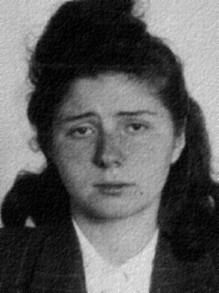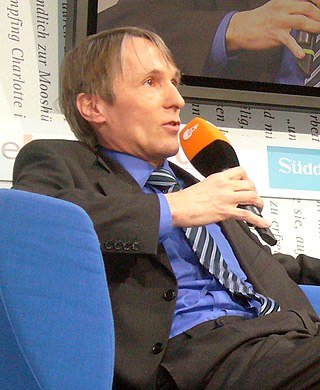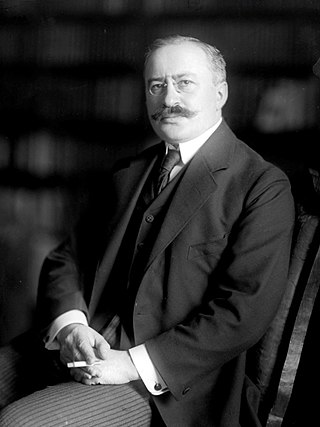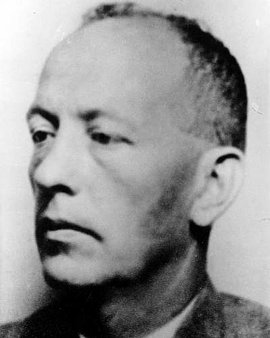
Liane Berkowitz was a German resistance fighter and was most notable for being a member of the Berlin-based pro-Soviet resistance group that coalesced around Harro Schulze-Boysen, that was later called the Red Orchestra by the Abwehr. Arrested and sentenced to death, she was executed shortly after she gave birth to a daughter in custody.

Elisabeth Schumacher was a German artist, photographer. and resistance fighter against the Nazi regime. She was a member of the Berlin-based anti-fascist resistance group that was later called the Red Orchestra by the Abwehr, during the Third Reich. Schumacher trained as an artist, but as her father was Jewish, who died in battlefield during World War I, she was classified as half-Jewish or Mischling, so worked as a graphic artist, before joining the resistance efforts.

Alexander (Alex) Beer was a German architect.

The Reichskriegsgericht was the highest military court in Germany between 1900 and 1945.

Hubertus Knabe is a German historian and was the scientific director of the Berlin-Hohenschönhausen Memorial, a museum and memorial in a notorious former Stasi torture prison in Berlin. Knabe is noted for several works on oppression in the former communist states of Eastern Europe, particularly in East Germany. He early became involved with Green politics, and was active in the Green Party in Germany.

Jerusalem Church is one of the churches of the Evangelical Congregation in the Friedrichstadt, a member of the Protestant umbrella organisation Evangelical Church of Berlin-Brandenburg-Silesian Upper Lusatia. The present church building is located in Berlin, borough Friedrichshain-Kreuzberg, in the quarter of Friedrichstadt. Jerusalem Church is fourth in rank of the oldest oratories in the town proper.

Ilse Frieda Gertrud Stöbe was a German journalist and anti-Nazi resistance fighter. She was born and died in Berlin.

Heinrich Koenen was a German engineer, anti-fascist resistance fighter and agent of the Soviet military intelligence service GRU, known as a "scout".

The Hackesche Höfe is a notable courtyard complex situated adjacent to the Hackescher Markt in the centre of Berlin. The complex consists of eight interconnected courtyards, accessed through a main arched entrance at number 40 Rosenthaler Straße.

The Gedenkstätte Berliner Mauer commemorates the division of Berlin by the Berlin Wall and the deaths that occurred there. The monument was created in 1998 by the Federal Republic of Germany and the Federal State of Berlin. It is located on Bernauer Straße at the corner of Ackerstraße and includes a Chapel of Reconciliation, the Berlin Wall Documentation Centre, a 60-metre (200 ft) section of the former border, a window of remembrance and a visitor center.

Theodor Wolff was a German writer who was influential as a journalist, critic and newspaper editor. He was born and died in Berlin. Between 1906 and 1933 he was the chief editor of the politically liberal newspaper Berliner Tageblatt.

Ursula Goetze was a Berlin student and resistance fighter, who participated in political opposition to the Nazi government in Germany. In May 1942, following involvement in a leafleting campaign, she was arrested and, some time later, sentenced to death. She died by decapitation with a guillotine.

Franz Leuninger was a German trade unionist, politician and resistant against the Nazis' rise to power and regime. Working as a bricklayer after school, he became a member of the trade union for construction workers early on, serving as its regional leader in Silesia in the 1920s. He was a member of the city council of Breslau for the Zentrumspartei from 1930, and ran for the German Reichstag in 1933, as a strong opponent of the Nazi party.
Elly Lotte Bergtel-Schleif, née Schleif, was a German librarian who was actively involved in the resistance against Nazis while a member of the Communist Party of Germany (KPD). Bergtel-Schleif became head of the Berlin Library School after the war.

Fritz Thiel was a German precision engineer and resistance fighter against the Nazi regime. He became part of a Berlin-based anti-fascist resistance group during World War II, that was later named the Red Orchestra by the Abwehr. Thiel along with his wife Hannelore were most notable for printing stickers using a child's toy rubber stamp kit, that they used to protest The Soviet Paradise exhibition in May 1942 in Berlin, that was held by the German regime to justify the war with the Soviet Union. The group found the exhibition both egregious and horrific; one exhibited photograph showed a young woman and her children hanged side by side. Thiel was executed for his resistance action.

Harald Poelchau was a German prison chaplain, religious socialist and member of the resistance against the Nazis. Poelchau grew up in Silesia. During the early 1920's, he studied Protestant theology at the University of Tübingen and the University of Marburg, followed by social work at the College of Political Science of Berlin. Poelchau gained a doctorate under Paul Tillich at Frankfurt University. In 1933, he became a prison chaplain in the Berlin prisons. With the coming of the Nazi regime in 1933, he became am anti-fascist. During the war, Poelchau and his wife Dorothee Poelchau helped victims of the Nazi's, hiding them and helping them escape. At the same time, as a prison chaplain he gave comfort to the many people in prison and those sentenced to death. After the war, he became involved in the reform of prisons in East Germany. In 1971, Yad Vashem named Poelchau and his wife Righteous Among the Nations.

Dorothee Poelchau was a German librarian who together with her husband Harald Poelchau, were resistance fighters against the Nazis. The couple were named Righteous Among the Nations in 1971.
People of the Saefkow-Jacob-Bästlein Organization is a list of participants, associates and helpers of the Saefkow-Jacob-Bästlein Organization, which was one of the largest anti-nazi resistance organisations that came into existence during World War II in Germany. It was formed in Berlin and had contacts to many other regions that hosted industrial manufacturing. It is therefore also referred to in the literature as the operational leadership of the Communist Party of Germany (KPD). However, it was not only communists among the groups of the Saefkov Jacob Bästlein organisation. The 506 known persons included about 200 before 1933 to the KPD, 22 to the Social Democratic Party of Germany (SPD) or to the Socialist Workers' Party of Germany (SAP) and around 200 were non-party; one in four was a woman. 160 men and women were unionized before 1933, more than 60 of them in the German Metal Workers' Union (DMV). The local or region is indicated for the people who worked outside Berlin and Brandenburg.

Marie Gertrud Anna Burde, nicknamed Mieze, was a German rag-and-bone woman who hid three young Jewish men during the Nazi era, thus saving their lives. Burde and the men first lived together in Burde's bare downstairs apartment in Berlin, and after her apartment building was destroyed by bombs, the group of four moved to Schönow near Bernau. They built a rude shelter on a lot that she owned there. Burde and three men — two brothers Alfred and Rolf Joseph and Arthur Fordanski — survived the war, but Alfred was in a concentration camp in the latter part of the war. What is known about Burde is based primarily on the memories of Rolf Joseph (1920–2012), who came from a religious Jewish family.




















